Sanatan Articles
Satyaagrah
Written on
Satyaagrah
Written on
Satyaagrah
Written on
Satyaagrah
Written on
Satyaagrah
Written on
JOIN SATYAAGRAH SOCIAL MEDIA
"In loyalty's absence, betrayal finds its stage": Indians sacrificed their life earnings to Netaji for a dream called freedom, Nehru, however, fancied a different richness: gifting it to Pakistan, Legacy decisions, they call it was one more great betrayal

It's truly astounding. Indians emptied their pockets, gave their life's earnings, all for the cause of freedom. Yet, what did Nehru do with the accumulated treasure of the INA? He contemplated giving a chunk of it to Pakistan. The very thought feels like a slap in the face of every Indian who ever contributed. "Pakistan had claimed a part of the said assets and it was agreed that the same should be divided between India and Pakistan in the ratio of 2:1," Nehru, our very first Prime Minister post-Independence, penned in his communication to Bengal's then Chief Minister regarding the INA funds procured from Singapore.
While the enigma of Netaji Subhas Chandra Bose's death continues to spark debates worldwide, the fate of the mammoth INA treasure has been somewhat shoved under the rug. It was this treasure, accumulated under Bose's diligent leadership from the pockets of Indians scattered across South East Asia, meant to challenge the Allied powers, which prominently included the British. Now, as per revelations by OpIndia, Nehru had actually conceded to hand over a fraction of this hard-earned fund to Pakistan. This move, covert and controversial, might just stand as the inaugural scam perpetuated under the banner of the Nehru-Gandhi Congress in a freshly independent India.
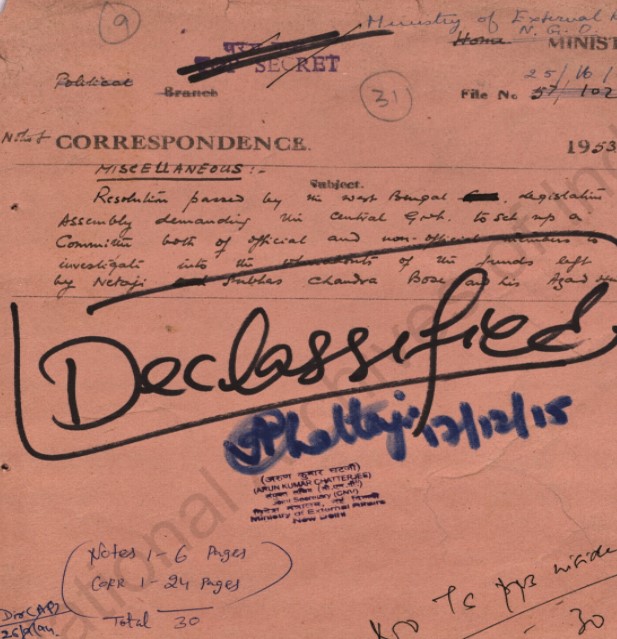 |
Zoom back to 2nd May 1953, a full eight years after Netaji's alleged demise. The West Bengal Legislative Assembly, perhaps sensing the weight of history and the call of responsibility, passed a resolution. Their demand? They urged the Nehru-led government to dive deep into the funds associated with Netaji and his valiant Azad Hind Fauj. The resolution, which echoed with the sentiments of countless Indians, emphatically stated: “This Assembly is of the opinion that the Central Government be requested to take steps to investigate regarding the funds reported to be left by Netaji Subhas Chandra Bose and his Azad Hind Government.” Such a noble quest had the full backing of the West Bengal government, steered then by Bidhan Chandra Roy.
 |
Yet, the response from Nehru, which came on 18th October 1953, felt nothing short of a cold bucket of water. Nehru, in a letter addressed to the Bengal CM, asserted that delving any deeper into the matter was both unnecessary and unfeasible. His words dripped with an almost condescending finality:
“My dear Chief Minister,
My attention has recently been drawn to a resolution passed by the West Bengal Legislature on May 2nd to the following effect:
‘This Assembly is of the opinion that the Central Government be requested to take steps to investigate regarding the funds reported to be left by Netaji Subhas Chandra Bose and his Azad Hind Government.’
As a matter of fact, we have taken many steps to investigate this matter during the last few years. The investigation was started by me personally when I visited Malaya early in 1946. Since then many other steps have been taken both in Malaya and in Tokyo. I enclose a note giving such information as we possess on this subject.
I do not think any further investigation is needed or is possible.“
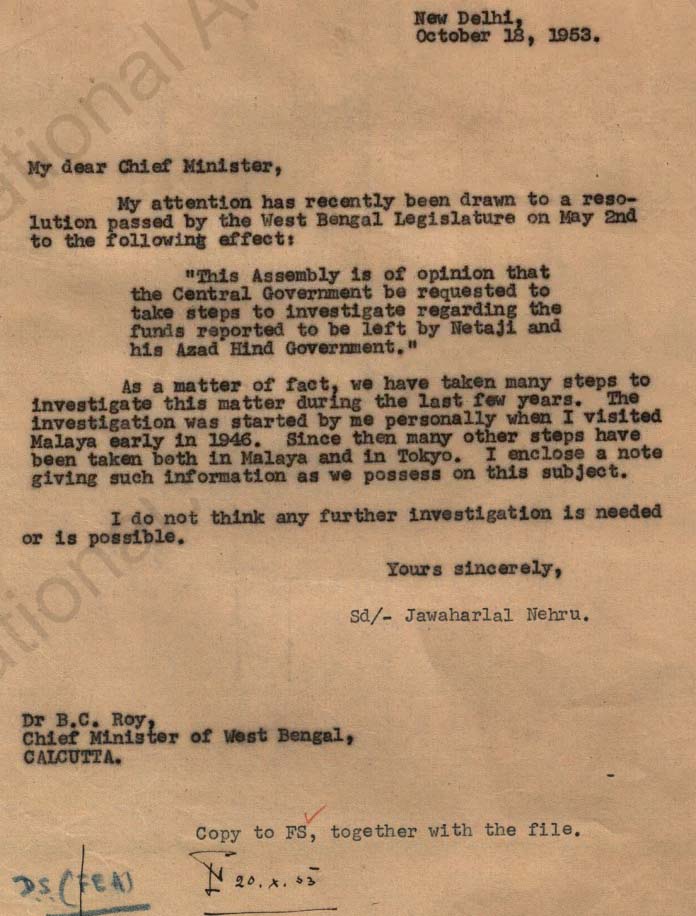 |
The audacity and the sheer dismissal evident in the correspondence are telling. The mystery deepens, the betrayal stings.
When the contents of Nehru's letter became public, it shed some intriguing light on the fates of the financial assets associated with Netaji Subhas Chandra Bose, the Indian National Army (INA), and their closely tied organizations. For those unfamiliar with this chapter of history, it's imperative to take a step back and understand its significance.
The setting was the dramatic conclusion of World War II, specifically in the Far East theatre. As the war clouds receded and the dust of battle settled, numerous discoveries were made. Among these was a staggering accumulation of gold, jewellery, and other valuables. This wasn't just any treasure; it symbolized the hopes, aspirations, and sacrifices of countless Indians. These assets had been painstakingly gathered from Indians across South East Asia, all united under the charismatic leadership of Netaji and the INA, to fund a singular cause - India's fight for freedom. However, rather than returning to the Indian motherland, these treasures were confiscated. They found themselves in the hands of the 'Custodian of Enemy Property' in Singapore, a title as imperialistic as it sounded.
In the subsequent detailed notes shared by Nehru with the West Bengal CM, a startling revelation came to the fore. Pakistan, a nation birthed at roughly the same time as Independent India, and having no direct association with the INA's efforts, audaciously laid claim to a portion of these assets. The narrative takes a puzzling turn when it's revealed that an agreement was struck to divide this treasure between India and Pakistan in a 2:1 ratio.
To delve deeper into this perplexing agreement, Nehru's note reads:
“Indian National Army and Indian Independence League Funds:
Soon after the termination of the last war in the far east, some quantity of gold, jewellery, and other valuables, was seized from the officials and others connected with the INA and IIL in the South East Asia countries. These are at present held in Singapore by the Custodian of Enemy Property.
According to the information furnished by the government of Singapore in 1950, these assets were valued at straits dollars 147,163.00 as follows:
a) Gold and jewellery: $40,243.00
b) Currency notes of the face value of $57,803.53 but valued in 1950 at: $106,920.00
Total: $147,163.00
The whole episode raises more questions than answers. Why was Pakistan laying claim to a treasure that had nothing to do with their history? Why did Nehru acquiesce to such demands? The legacy of the INA's treasure, sadly, wasn't just about the freedom struggle but also about post-independence politics and diplomacy.
As if the entire saga surrounding the INA's treasure wasn't convoluted enough, fresh information trickled in from India's representative in Malaya. The Piastra, which was a currency once common in several Asian countries, had undergone a revaluation. This twist threw a wrench in the already complex situation. The revaluation indicated that some of the accumulated currencies might now be deemed worthless, making it a challenge to determine the precise worth of these invaluable assets. One can only imagine the heartache this news might have caused to countless Indians who remembered donating their cherished possessions for the noble cause.
The plot thickened with Pakistan's entry into the fray. The audacious claim by the neighboring country over assets that had nothing to do with its freedom struggle is perplexing. It begs the question: On what basis was Pakistan staking a claim? The ensuing negotiations between India and Pakistan were, predictably, long-winded and tense. After what seemed like an eternity, an agreement was reached to divide the assets in a 2:1 ratio. But why was this ratio chosen? And why was there even an agreement to divide assets that were the fruits of sacrifices made by Indians, specifically for India's freedom?
Intimation has recently been received from our representative in Malaya that the Piastra has been revalued and that some of the currencies will not fetch anything. It is therefore difficult to assess the exact value of these assets.
“There were protracted negotiations with Pakistan, as she claimed a part of these assets. In the end, it was agreed that the assets should be divided between India and Pakistan in the ratio of 2:1. We asked out representative in Malaya on the 27th of April and also Mr. Ramani who was associated with this matter from the very beginning to take further action and to obtain the release of the assets from the Singapore government. Mr. Blythe the official administering the colony, said in May 1953 that the matter would have to go before the legislative council as the custodian of enemy property had no right to hand over any amount to any person or body. He also wished to write to the secretary of state for the colonies regarding Pakistan’s share. The amount will accrue to India will be amalgamated with the IRC funds, as soon as it is obtained from the government of Singapore,” the documents read.
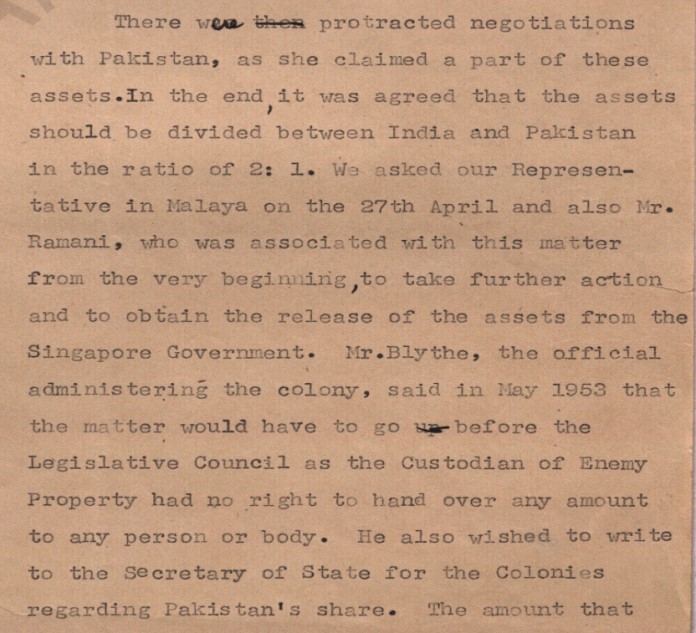 |
Determined to get the assets released, the Indian government deputed its representative in Malaya. They were further assisted by Mr. Ramani, a key figure familiar with the treasure's history from the outset. Their primary mission was to navigate the bureaucratic labyrinth and ensure the assets' release from the Singapore government.
However, another obstacle arose in the form of Mr. Blythe, the official overseeing the colony. He pointed out that the decision wasn't as simple as handing over the treasure to India. In a move that smacked of red tape, he mentioned that such a significant matter would require the approval of the legislative council. This is because, technically, the 'Custodian of Enemy Property' lacked the authority to disburse any amount to anyone. It's intriguing to ponder why this title even existed post the wartime era and why they were handling assets tied to India's freedom struggle. Adding another layer to this complex tapestry, Mr. Blythe expressed his intent to communicate with the secretary of state for the colonies concerning Pakistan's share.
The documents conclude with the statement that once procured, the amount destined for India would be combined with the IRC funds. The sheer number of twists and turns in this narrative is mind-boggling. The treasure, symbolizing India's hope and sacrifice, seemed ensnared in a web of international politics and bureaucracy.
A Tangled Web of Nehru's Decisions: A Deep Dive into the INA/IIL Fund-Sharing Conundrum
It's curious, isn't it, how the treasure amassed by the sacrifices of countless Indians seemed to be volleyed back and forth within governmental corridors? Nehru's decision, one of the many enigmatic ones in his tenure, to share the INA/IIL funds in a 2:1 ratio with Pakistan, turned the situation even murkier. As this pact played out, it's striking to observe how the bureaucratic gears suddenly churned with full force, primarily focusing on "Pakistan’s share." This intricate tangle of politics and diplomacy seemed to overshadow the actual essence of the treasure - a collective contribution for India's freedom.
In a rather perplexing move, Nehru, the architect of the 2:1 sharing plan, later announced that the gold he described as, "which was in a sense given to me and deposited by me in the bank in 1946" should be viewed distinctively from the "other INA funds". One might ask, why this sudden distinction?
 |
Adding another layer of complexity to this already convoluted story, diplomat VMM Nair entered the narrative. In a correspondence dated 12th November 1953, Nair sought clarification from Nehru about the exact worth of gold procured from Hardial Singh. The golden cache was pegged at a seemingly modest sum of Rs 37,956. For an amount accumulated from the masses in hopes of a brighter future for their nation, was this valuation even apt?
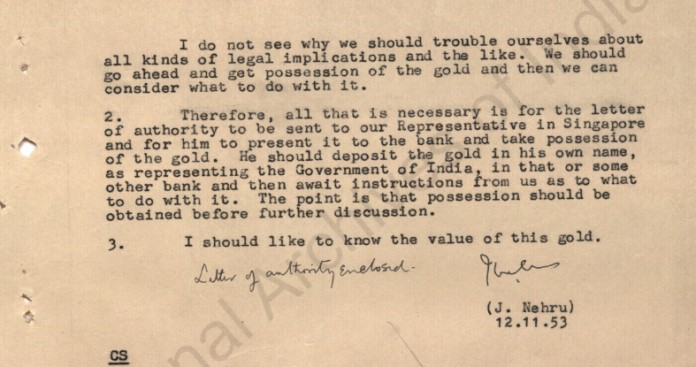 Nair sought clarification from Nehru about the exact worth of gold procured from Hardial Sing |
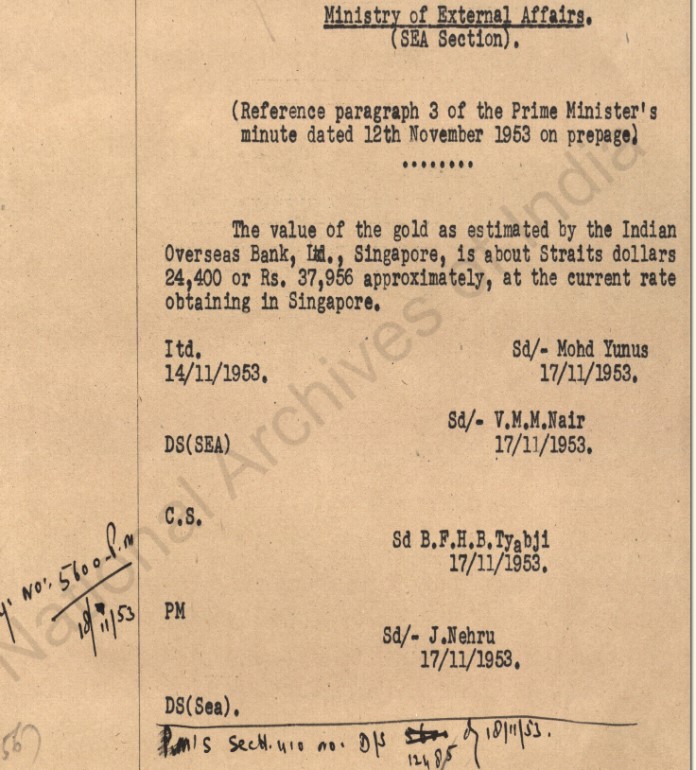 The value of the gold was estimated at Rs 37,956. |
However, the mystery doesn’t end here. Delving into netajipapers.gov.in, one stumbles upon another communication by Nehru that follows the earlier letter regarding the gold's valuation. Curiously, this letter, which discusses the same gold, is dated more than a year later, on 12th January 1955. In this letter, Nehru appears almost dismissive of the entire scenario, terming it a "trivial matter." But was it truly trivial, given the emotions and hopes tied to it?
Nehru's correspondence reads:
“This is a trivial matter which has already taken up a good deal of our time. The sum involved is small and we have no objection at all to its being used in consultation with Pakistan or, in the alternative, for Pakistan’s share, if any, to be handed over to them for such use as they may like to put it to."
While the specific amount Nehru referenced remains ambiguous, the documents lean heavily towards the above-mentioned valuation. This decision, like many others related to the treasure, opens up more questions than answers. Why was Nehru so willing to consult with Pakistan on an amount rooted in the Indian freedom struggle? Was it the weight of political diplomacy, or a gross oversight of the value the treasure represented for millions of Indians?
As the narrative unfolds, Nehru's acknowledgment of the gold's association with the INA and IIL is explicit. His words confirm that there was no ambiguity or implied understandings, but rather, a clear connection. He states, “It is perfectly true that we have accepted the position that gold forms part of the old INA and IIL. There is nothing tacit about it. It is quite implicit.”
His instructions to the Indian representative in Malaya seem consistent with his past approach. He emphasizes the priority of ensuring the proper utilization of the funds. Nehru's reference to an educational trust fund indicates a wish to use these funds for a noble cause. The idea of associating Pakistan or allocating a portion of the funds to them reveals a diplomatic, albeit controversial, approach to managing these assets.
The closing reflection provides a somber backdrop against which Nehru's decisions were made. Post-independence, India grappled with a gamut of challenges. From a deteriorated GDP, rampant poverty, widespread famine, to a fractured economy due to Nehru’s socialist ideologies, the nation was on its knees. In such a fragile setting, every financial asset was invaluable.
Yet, Nehru's proposal to allocate a segment of INA's funds to Pakistan, a nation born out of a violent partition, is both surprising and contentious. This isn't merely about monetary resources; it's about the emotional and symbolic value these funds carried. They represented the dreams and sacrifices of freedom fighters, and their allocation could not be made lightly.
History is often a web of decisions, circumstances, and interpretations. Nehru, the central figure in this narrative, made choices that would leave a lasting imprint on India's post-independence journey. While the INA/IIL funds saga might be one episode in a larger story, it serves as a reminder of the complexities that leaders face, the diplomatic tussles they get entwined in, and the profound impact of their decisions. Whether perceived as a diplomatic maneuver or a betrayal of the ideals of freedom fighters, Nehru's actions with the INA/IIL funds will remain a debated chapter in the annals of Indian history.
 Support Us
Support Us
Satyagraha was born from the heart of our land, with an undying aim to unveil the true essence of Bharat. It seeks to illuminate the hidden tales of our valiant freedom fighters and the rich chronicles that haven't yet sung their complete melody in the mainstream.
While platforms like NDTV and 'The Wire' effortlessly garner funds under the banner of safeguarding democracy, we at Satyagraha walk a different path. Our strength and resonance come from you. In this journey to weave a stronger Bharat, every little contribution amplifies our voice. Let's come together, contribute as you can, and champion the true spirit of our nation.
 |  |  |
| ICICI Bank of Satyaagrah | Razorpay Bank of Satyaagrah | PayPal Bank of Satyaagrah - For International Payments |
If all above doesn't work, then try the LINK below:
Please share the article on other platforms
DISCLAIMER: The author is solely responsible for the views expressed in this article. The author carries the responsibility for citing and/or licensing of images utilized within the text. The website also frequently uses non-commercial images for representational purposes only in line with the article. We are not responsible for the authenticity of such images. If some images have a copyright issue, we request the person/entity to contact us at This email address is being protected from spambots. You need JavaScript enabled to view it. and we will take the necessary actions to resolve the issue.
Related Articles
- "You cannot change what you refuse to confront": Ashutosh Lahiry approached Nehru seeking assistance for the suffering Hindu refugees and to take action to alleviate their plight, but Nehru refused citing his commitment to Gandhian pacifism and secularism
- Harmonizing Nathuram Godse: Why India should move beyond denouncing him, a man who altered the course of not only the politics of the country but the very history of the Hindu Civilisation and, by extension, the world at large
- During ‘Kheti Bachao Yatra’ in Kurukshetra Shehjada Gandhi claimed of throwing China out from Indian Territory ‘in 15 minutes’: From Nehru’s Himalayan blunder to UPA’s silence as China took over Indian land in Ladakh
- Nehru's Himalayan Blunders which costed India dearly - Pre-Independence
- The first large-scale massacre in Independent India accounts for one of the biggest coverups in modern history: It is about time we talk about the 1948 genocide of Maharashtrian Brahmins following MK Gandhi’s assassination
- If only India’s partition chilling wound was not enough, Gandhi did his last protest again only to blackmail India into giving 55 crores to Pakistan, dragged Hindu, Sikh refugees seeking shelter in mosques to die in cold: And we call him Mahatma, not for
- "Betrayal is the birthplace of resentment": Diving into murky depths of Nehru & Elwin's policies in Northeast India unveils a legacy of disruption, a region converted, culture exploited & nation betrayed - glaring testament to their ill-conceived actions
- When Nehru ignored warnings from Sardar Patel and Sri Aurobindo and shocked USA President: Chinese Betryal and loss of centuries old ally
- When Secular Nehru Opposed Restoration Of Somnath Temple - The Somnath Temple treachery
- Netaji, an Impossible man can never be boxed into an ideological corner: Not just the most enigmatic figure in world history but his life is also a tough lesson in how to think about history
- Ghost from the past: Unseen picture of Nehru voting in favour of partition of India goes viral
- The untold story of Maharashtrian Brahmin genocide committed by Congress after Gandhi’s assassination in 1948
- British PM accepted that “the tide of nationalism is running very fast in India" and the mutiny of the Royal Indian Navy in 1946 forced colonial masters Britain to leave India: What followed was betrayal by Congress
- China attacked India just three years after PM Nehru reduced the defence expenditure by Rs 25 crores: Union Budget 1959
- Birth of our National Anthem: Original recording of 'Jana Gana Mana' performed by the Radio Symphony Orchestra of Hamburg, Germany, 1942 in the presence of Netaji Subhash Chandra Bose





















